Germany
Würzburg Residence
The Würzburg Residence with the Court Gardens and Residence Square represents a highlight in 18th-century Baroque palace architecture.
Two successive Prince-Bishops of the Würzburg ecclesiastical principality hired prominent international architects (from Vienna, Venice, Paris), painters, sculptors, and stucco workers to create a splendid residence with 300 rooms. The ceiling over the broad staircase, the walls of the Imperial Hall and the church altar are decorated with frescoes made by the Venetian master Tiepolo.
Community Perspective: A must-visit for its Tiepolo frescoes, but there is also the route around the palace “with the usual array of ornate bedchambers, wardrobes and halls”. Caspar and Jay have described what you may expect from the guided tour. Triath reports that in 2024, you can visit individually and the restriction on taking photos has been lifted.
Site Info
Official Information
- Full Name
- Würzburg Residence with the Court Gardens and Residence Square (ID: 169)
- Country
- Germany
- Status
-
Inscribed 1981
Site history
History of Würzburg Residence
- 1981: Inscribed
- Inscribed
- Type
- Cultural
- Criteria
- i
- iv
Links
- UNESCO
- whc.unesco.org
- Official
-
- residenz-wuerzburg.de — Würzburg Residenz
- Related
-
- home.bawue.de — Link
All Links
UNESCO.org
- whc.unesco.org — whc.unesco.org/
Official Website
- residenz-wuerzburg.de — Würzburg Residenz
Related Resources
- home.bawue.de — Link
Community Information
- Community Category
- Secular structure: Palace
Travel Information
Recent Connections
-
Perfect Inscriptions
1981 -
Queen Victoria slept here
1845 August 18-19. To visit Luitpold, P… -
Designed by Balthasar Neumann
Lead architect of the palace
Connections of Würzburg Residence
- Individual People
-
-
Queen Victoria slept here
1845 August 18-19. To visit Luitpold, Prince Regent of Bavaria on way to Coburg (Birthplace of her husband Albert)
-
- Trivia
-
-
On Banknotes
partial view of Staircase; 50 DM; 1989See en.wikipedia.org
-
Modelled after
After Versailles
-
- Architecture
-
-
Designed by Balthasar Neumann
Lead architect of the palace -
Rococo
Several rooms -
Baroque
-
Domes
stair-house -
French (formal) garden
-
- Damaged
-
-
Damaged in World War II
As a result of a devastating air raid on 16 March 1945, the residence was almost completely burnt out and only the central building with the Vestibule, Garden Hall, Staircase, White Hall and Imperial Hall survived the inferno, their roofs destroyed. (wiki)See en.wikipedia.org
-
- World Heritage Process
-
-
Perfect Inscriptions
1981
-
- Human Activity
-
-
Cannibalism
Tiepolo fresco at the stairway: America has natives with feathers, who practice cannibalism of prisoners (wiki) -
Gilded Lacquer or Urushi
Grün lackiertes Zimmer with silver and green lacquer. -
Frescoes or murals by famous painters
Tiepolo -
Self-portraits
Tiepolo at the Europe group of the staircase fresco
-
- Constructions
-
-
Tunnels
63-meter-long tunnel connecting the wine cellars with tanks, now transformed into a 'history tunnel' -
Large squares
Residenzplatz 30,000 m2 -
Monumental Fountains
Franconia FountainSee vanderkrogt.net
-
- Timeline
- WHS Hotspots
- Science and Technology
-
-
Universities
About half of the palace serves as the seat of departments of the University of Wuerzburg.
-
- Literature & Film
-
-
Used in film as another WHS
used as the Louvre in the Three Musketeers (2011)
-
News
No news.
Recent Visitors
Visitors of Würzburg Residence
- Adrian
- Adrian Turtschi
- Alexander Barabanov
- Alexander Lehmann
- Ali Zingstra
- A. Mehmet Haksever
- Ana Lozano
- AndreaTLV
- Anna Wludarska
- anthonybonbon
- Argo
- AS
- Aspasia
- Assif
- Astraftis
- a.thum
- Atila Ege
- Aunti
- awestix
- AYB
- Badwater
- BaziFettehenne
- Bernard Joseph Esposo Guerrero
- Bill Maurmann
- Bin
- Brendan Carroll
- Bropyk
- butterflybird
- c82wc1
- CampbellME
- Can SARICA
- Caspar
- chenboada
- chenqtao
- Cheryl
- CherylKla
- Chole Ross
- Christer Sundberg
- Christian Wagner
- christof
- Christoph
- Christravelblog
- Claire Bradshaw
- Cluckily
- Clyde
- Cobaltrage
- Colossus
- Corinne Vail
- Cristina Erba
- Csaba Nováczky
- ctravel
- CugelVance
- cwthong
- Dagmara
- Daniela Hohmann
- Daniel Chazad
- Daniel Gabi
- Danny L
- David Berlanda
- DavidS
- DimiFW
- Dimitar Krastev
- Dimitrios Polychronopoulos
- Dirk-pieter
- Dolemite92
- Dorejd
- DouglasR
- Echwel
- Eirini
- Elaine McArdle
- Els Slots
- erdsaumnaht
- Eric Lurio
- Erik Jelinek
- Errol Neo
- Ertai
- Eva Kisgyorgy
- Evgenii
- fabi-ddorf
- Fam39
- Fan Yibo
- Farinelli
- Federico P.
- Feldhase
- Femke Roos
- Filip Murlak
- Filippo Ubaldi
- FK
- Frederik Dawson
- FS
- Gary Arndt
- Geert Luiken
- George Gdanski
- GeorgeIng61
- GerhardM
- Gernot
- Giannis75
- Grendel Gongan
- Hadrianus
- Harald T.
- Harry Mitsidis
- henrik_hannfors
- heywhatever2
- hszaby
- Hubert
- Hurrvinek
- Iain Jackson
- Ian Cade
- Ivan
- Ivan Rucek
- Jacob Otten
- Jakob F.
- Janina Lehmann
- janis
- Jan Korpeg
- Jan-Willem
- Jan Zimmermann
- Jarek Pokrzywnicki
- Javier Coro
- Jay T
- Jean Lecaillon
- Jens
- Jesse S 2010
- Jezza
- JobStopar
- Joel on the Road
- Johan
- Jonas Hagung
- Jonas Kremer
- Jon Bauer
- Jonoprout
- JoStof
- Joyce van Soest
- Jurre
- KarenBMoore
- Karito Vies
- Kasia M.
- Kbecq
- KeithBailey
- Ken DJ
- Kerékgyártó
- Klaus Freisinger
- Knut
- Kurt Lauer
- Lara Adler
- Laurey
- LaVale
- Leafar98
- lichia
- Lisu Marian
- ljowers
- Loic Pedras
- Luboang
- Lucio
- Ludvan
- Luis Filipe Gaspar
- lynnz317@aol.com
- Maciej Gil
- Maciej Gowin
- Mahuhe
- Malgorzata Kopczynska
- Małgosia Łupicka
- Manuelfunk
- marcel staron
- MarcoB_0
- Marcobrey
- marc Rouserez
- Martin
- Martina Rúčková
- Marty
- MaxHeAnouBen
- MaYumin
- MH
- MichaelH
- michaelsballard
- MichaelStro
- Michael Turtle
- Mikko
- Mikko Syrjä
- Milan Jirasek
- Miloš Tašković
- MMM
- Mohboh
- MoPython
- Mozzer76
- Naim Y
- nan
- Nasebaer
- natlefebvre@hotmail.
- Nick M
- Nicole Lampos
- Nihal Ege
- NoahFranc
- opperpco3
- PabloNorte
- Patrik
- Patrik_globe
- Paul Schofield
- PeterH
- Peter Lööv
- Petteri
- Philipp Leu
- Philipp Peterer
- PlacesWeHaveBeenTo
- Porcho
- Potsdamer
- Purrfect
- Rafał Kałczuga
- Ralf Regele
- Ralf Rotheimer
- Randi Thomsen
- ReallyDeepThoughts
- Reisedachs
- Remigiusz
- Remski
- Reza
- Rick Ohm
- rivr
- Roel Sterken
- Roger Ourset
- Roman Bruehwiler
- Roman Raab
- Rudegirl
- Sabrina Liebehentschel
- Sandmann15
- Schnitzel
- Sebasfhb
- Sehnsuchtsbummler
- Sergio Arjona
- Shandos Cleaver
- Shijie ZHU
- shoaibmnagi
- sime147
- SirLoydd
- Slavi
- Solivagant
- Stanislaw Warwas
- Stefan A. Michelfeit
- Stijn
- Svein Elias
- Szucs Tamas
- Tamara Ratz
- Tammy Gouldstone
- Taotao Chen
- Tarquinio_Superbo
- Tevity
- TheDarlingLife
- Thomas Buechler
- Thomas Harold Watson
- Thomas van der Walt
- Thorben
- Tinuszke
- Tommy W
- triath
- Tschibi
- Tsunami
- Twobaconsandaboston
- UncleSlavi
- usagi1974
- Vanessa Buechler
- Van Hung
- Veronica
- viktor_balandin
- VLabhard
- WalGra
- Walter
- Westwards
- Wimmy
- Wojciech Fedoruk
- Wo_ko
- Xiquinho Silva
- Yang Chengyu
- YaroMir
- Yevhen Ivanovych
- Zhenjun Liu
- Zoë Sheng
- Zos M
- Zsuzsanna Forray
Community Reviews
Show full reviews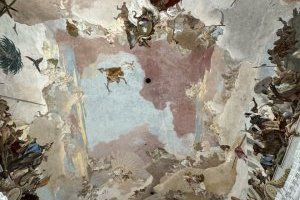
I read the previous reviews, and it looks like the rules of visiting have changed radically. Firstly, you can visit the residence not only with a group tour, I arrived late and missed the last English-language tour, but it turned out that you can visit individually, at your own pace. Another important change is that the ban on photography has been removed, now you can take pictures everywhere. The admission is 9 euro (ICOM members for free), the admission to the Court Church and the Court Garden is free.
The residence was built during the strengthening of the local prince-bishops, who actually ruled eastern Franconia. But the bishops achieved special power when this position was monopolized by representatives of the Schönborn family, the most famous of whom was Friedrich Carl von Schönborn, who was the imperial vice-chancellor for a long time (1705-34), fought against the growing expansion of Prussia, supported the emperor in the fight against the papacy (such a bishop!). The manifestation of his political ambitions was the construction of a new luxurious episcopal residence, the architect Balthasar Neumann worked on its creation in 1709-44, and the most outstanding artist of the Rococo era, Giovanni Battista Tiepolo, was engaged in decoration. It is interesting that the residence has many allusions to the support of the Habsburgs, so the lobby is programmatically decorated with a depiction of the feats of Hercules, and one of the richest rooms is the imperial bedroom, where the Habsburgs were supposed to stay (of …
Keep reading 0 comments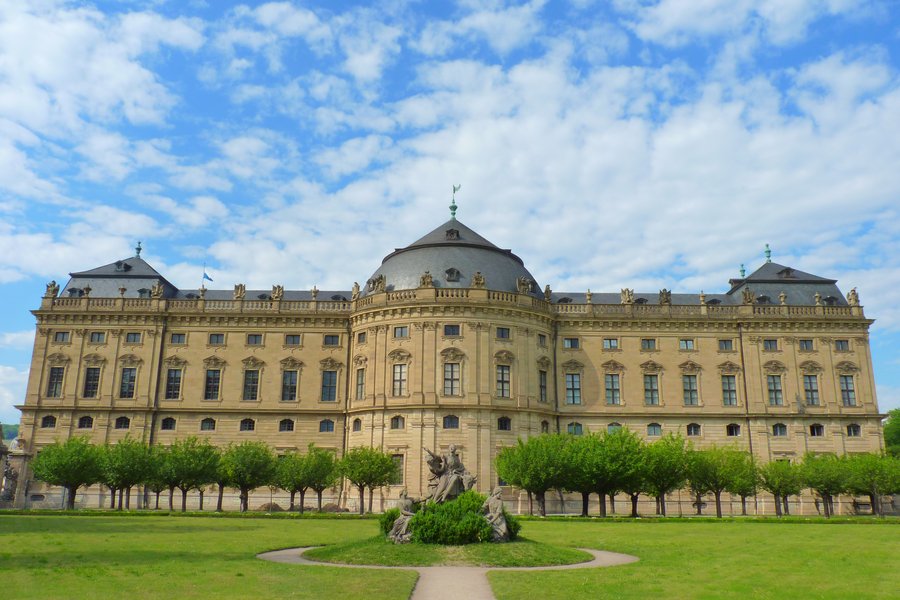
During my visit to Wurzburg, I couldn't miss the Residence. It is definitely impressive, especially from the inside. What's even more impressive than the building itself, is the fact that it was almost completely destroyed as a result of the British bombing during the World War Two and rebuilt after that. The building used to be the residence of Wurzburg bishops and now is open for the public and it is one of the best example of the Baroque palaces in Europe. The gardens also look great, but after seeing the interior, they don't impress that much, but they are worth visiting anyway.
Keep reading 0 comments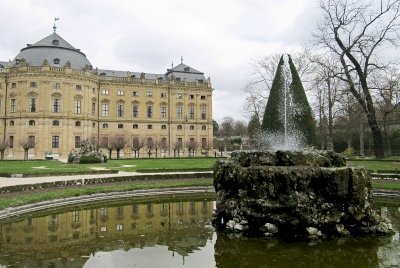
In these days of social distancing and stay-at-home orders, what better World Heritage Site could there be to review than one whose Outstanding Universal Value is best appreciated from the inside: the Würzburg Residence (with the Court Gardens and Residence Square). So why do I attach a picture of the outside of the residence if the interior is superior to the exterior? Unfortunately, the Würzburg Residence is one of the World Heritage Sites that does not allow for interior photography, ostensibly because it hinders group tours.
Nevertheless, I do recommend a visit to the palace to see the interior, for the architecture and frescoes are marvelous. The Würzburg Residence was designed by German architect Balthasar Neumann and constructed in Baroque style during the 18th century. I appreciated my first glimpse of the house during my wait for the tour to begin in Neumann's fantastic Garden Hall on the ground floor when I visited in March of 2019. The tour continued to the grand staircase, meant to impress all visitors to the residence and topped with master artist Giovanni Tiepolo's magnificent Apollo and the Four Continents on the ceiling, apparently the largest fresco in the world. I really liked this work, and was amused at Tiepolo's interpretation of America, which remained largely unknown to him.
I would gladly have spent more time studying the fresco, but the tour continued through the first floor to the other two main highlights of the house: the Imperial Hall (or Kaisersaal) and the …
Keep reading 0 comments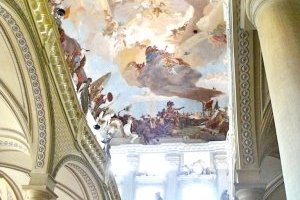
I visited this palace in August 2011. Obviously it was forbidden to take pictures since I have only one picture of the famous staircase. While this residence does not rival other European palaces in size it is remarkable in several ways: it was built by a prince-bishop who was the sovereign over a small country. It was built by the greatest artists of the Rococo among them Balthasar Neumann and Tiepolo and it contains three of the most beautiful palatial rooms I have ever seen, in taste and refinement hardly rivaled by its greatest competitors. While baroque style often overwhelms me by its weight this rococo palace seems light and airy.
When you walk up to the Beletage you pass the enormous staircase with the largest fresco in the world painted by the Tiepolo. It is a over-the-top apotheosis of the bishop and each side of the ceiling shows one of the four then known continents. It is very entertaining to study them and see what was considered typical for each continents at the time. It is full of exotic animals and shows even native Americans who practice cannibalism! If I remember correctly our guide said that the four continents should signify the "global" power and influence of the prince-bishop. The latter is also protrayed and with him Tiepolo, Neumann and other artists. The first room on the second floor is the "White Room" which is quite monochromatic and all over decorated by stucco by Antonio Bossi, a real …
Keep reading 0 comments
I went with friends to Würzburg in May 2015, where we know a fellow studying at the city's university. The art historian Kenneth Clark visited the Residence in his landmark 1969 series Civilisation, in which he wondered how much the local people forked over in tithes and taxes in order for the bishop to build such a marvellous abode. Perhaps it was worth it, for the Residence houses one of the greatest works of the Venetian master Tiepolo (of whom more can be seen in the Doge's Palace).
There are over 300 rooms in the residence, many of them restored since destruction in World War II. All-in-all, though, we came out of the Residence feeling a little underwhelmed. We had expected something grander, I think: a more impressive fresco with the wow-factor of those in the Sistine Chapel – however unrealistic that now seems. It was impressive, of course, but not what we had hoped.
But there was more left to see. On a small sign I spotted an arrow pointing to the Residence’s Hofkirche, or Court Chapel. The work of Balthazar Neumann, this chapel really took our breath away, being impossibly ornate and riotous with colour and shape. Inside an inconspicuous wing of the Residence, Neumann took a rectangular space and transformed its interior into three overlapping ovals. Like with Gaudí, there are few straight lines. The overall effect is one of majesty, which must be so difficult to achieve in such a small space.
Keep reading 0 comments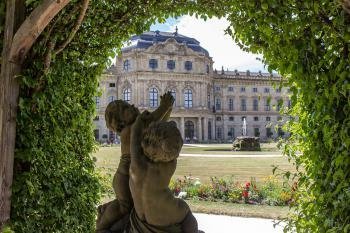
What is so incredible about this site is to think that it was all basically destroyed in the Second World War and then painstakingly restored to exactly how it was before (for 40 years and at a cost of 20 million euros!).
The building is enormous and everything is so grand and beautiful inside. Unfortunately you can't take photos inside, but it does give you the chance to look at everything in detail and soak it up. It takes at least an hour to walk through and see everything - even longer if you are really careful.
Make sure you don't miss the gardens at the back of the residence (which are free to get into anyway). The landscaping is wonderful and I would suggest walking right up to the top at the back to get a view of the garden with the building to see how it all fits together.
Keep reading 0 comments
I visited this WHS in May 2012. This Baroque palace with its gardens is one of the largest and most beautiful in Germany. The architectural symmetry of this Bavarian palace was the highlight of my visit.
Keep reading 0 comments
I have been to the Residenz many times as I used to live in Wurzburg and I visit whenever I am back in Germany. I took my family there a few weeks ago for the first time and they loved it. The staircase is an amazing piece of art and is always my main reason for visiting. It's beautiful and well worth the visit. I forgot to go into the chapel accessed from the side of the palace. Don't forget if you visit because it is also very impressive.
Keep reading 0 comments
Würzburg is a very pretty and easily accessible town in northern Bavaria, between Frankfurt and Nuremberg. The old town is very compact, can be conveniently explored on foot, and has several interesting buildings and a nice bridge over the Main River with many statues, resembling Charles Bridge in Prague. The highlight, of course, is the baroque residence of the prince-bishops, who, during their rather short heyday in the 18th century, commissioned many famous artists to create a palace worthy of their importance. The result is one of the most beautiful palaces in Europe - on the inside, that is, because the outside is really not that special. The staircase and the frescoes on the ceiling are especially impressive. The name of the WH site even includes the Court Gardens behind the residence, which are certainly nice to walk through, and the Residence Square in front, which is usually used as a big parking lot...
All in all a very worthy WH site, and one that is very easy to reach as well.
Keep reading 0 comments
I visited The Residence in 2004 and unfortunately they were revamping the paintings on the ceiling so I didn't get to see the real beauty of it but did love the rest of the tour.I enjoyed the city so very much that I returned back the following September and spent more time there. I loved walking around Wurzburg, my hotel was a skip to the walking bridge across the Main. Visited many areas of Germany when I was there but loved Wurzburg the most.
Keep reading 0 comments
This is worth seeing...as it was winter when I visited the gardens were not in bloom. The inside of the Residence itself was indescribable. The paintings, the furniture, the ceilings everything was so gorgeous. The marble floors, the entryway and stairs and don't forget the room of mirrors are so breathtaking. If you have time visit and take the tour. Michelle
Keep reading 0 comments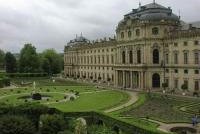
This grand building is definitely worth a visit. On the outside it might not look very special, but the inside sure is. When you walk up the stairs you will see huge paintings on the ceiling; what makes the paintings stand out is that they have lots of depth. Also in some places the ornaments that are part of the ceiling and walls blend right into the paintings themselves. In other rooms there are crazy ornaments on the wall up to the ceiling. In the "green room" with a wonderful wooden floor there’s lots of mirrors from where you can see each other from different points of view (ask the guide in the room about it). Finish your visit with a nice stroll through the gardens, and while you’re there, visit the town of Würzburg since it’s quite a pretty town.
Keep reading 0 comments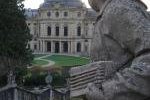
Franconia is always my favorite area in Germany and Würzburg is one of my many favorite cities in this region. The city itself is very nice with many beautiful old buildings and the Marienburg fortress on the hill can easily capture your imagination of romantic Germany – actually Würzburg is a starting point of the famous “Romantische Strasse”. However romantic can not save this city from the war, the city was almost completely destroyed during the WWII including the WHS in this city, the Residenz.
Würzburg residenz is considered as a masterpiece of baroque palace designed by Balthasar Neumann and built by yellow sandstone making this palace glows like a shinning moon in the dusk. In my opinion it seems that the late evening is the best time to enjoy the magnificent feeling of this palace. The Residenz and its square are huge compared to other places in the town making the Residenz look more striking. The garden is also marvelous with many lovely flowers and statues.
However, the palace’s inside gives the feeling of mix. The grand staircase is truly gorgeous with the fresco masterpiece by Tiepolo, Court chapel is just amazing, the green room is worth for special noticed, and about 10 lovely rooms of baroque and rococo styles which can be seen in many German baroque palaces like Schönbrunn or Sanssouci. After seeing of those mentioned, the palace becomes a long series of empty rooms with displays some ridiculous amount of fine art (OK the exhibition about …
Keep reading 0 comments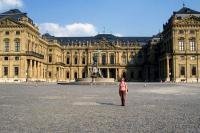
I know of no other UNESCO “Evaluation” which is so peremptory in its conclusion as that for this palace:- “The inclusion of the Wurzburg Residence on the World Heritage List constitutes a measure, which is so clearly desirable that the proposal of the Federal Republic of Germany does not require lengthly (sic) justification.”. So that’s that then….!
The WHS list isn’t short of “Baroque Palaces” but this is a great example of its type and, whether you like “Baroque” or not, should be seen by all “WHS enthusiasts” - if only for the giant Tiepolo frescoes.
Keep reading 0 comments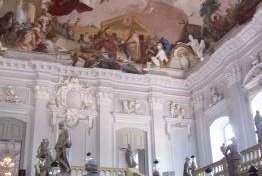
My enthusiasm for Palaces is very low, however the main staircase of the Residence is well worth the effort to see. It is one of the finest pieces of Baroque art anywhere, and the work of two of the periods leading talents: Neumann and Tiepolo. The ceiling fresco is magnificent and is reputedly the largest in the world. You are not actually allowed to take any photos inside, but I did manage to take a few sneaky ones. The decoration is on a much larger scale than the palace at Brühl, also by Neumann and also a WHS, but it is somehow a little more restrained, if you can use that term to describe Baroque.
In the other rooms there are some impressive restorations going on and you do get a good idea of how the process takes place, especially interesting is the display on restoration after the damage brought by Second World War. After this it seems to be the usual route around the usual array of ornate bedchambers, wardrobes and halls, very impressive, just not my favourite things.
The gardens were well laid out and free to enter, and worth exploring. As Frederik has said below the Court Chapel is amazing, well worth heading into even if you don’t go into the Palace itself, the paintings here are also by Tiepolo.
The town of Würzburg is well worth some time on its own, with some lovely churches, an impressive bridge lined with Baroque statues a-la Charles Bridge in …
Keep reading 0 comments